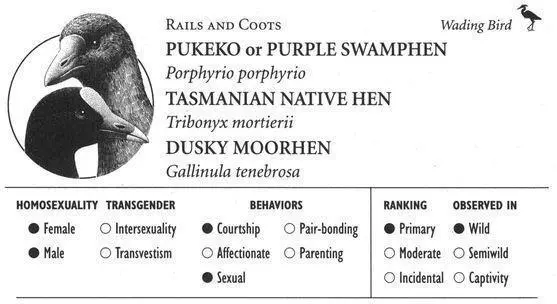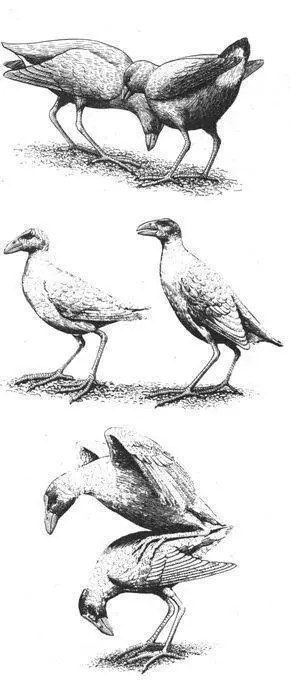Sources
*asterisked references discuss homosexuality/transgender
Blaker, D. (1969) “Behavior of the Cattle Egret Ardeola ibis.” Ostrich 40:75-129.
*Fujioka, M. (1996) Personal communication.
———(1989) “Mate and Nestling Desertion in Colonial Little Egrets.” Auk 106:292-302.
*———(1988) “Extrapair Copulations in Little Egrets ( Egretta garzetta ) .” Paper presented at the annual meeting of the Animal Behavior Society, University of Montana.
———(1986a) “Infanticide by a Male Parent and by a New Female Mate in Colonial Egrets.” Auk 103:619—21.
———(1986b) “Two Cases of Bigyny in the Cattle Egret Bubulcus ibis.” Ibis 128:419—22.
———(1985) “Sibling Competition and Siblicide in Asynchronously-Hatching Broods of the Cattle Egret Bubulcus ibis.” Animal Behavior 33:1228-42.
*Fujioka, M., and S. Yamagishi (1981) “Extramarital and Pair Copulations in the Cattle Egret.” Auk 98:134—44.
Lancaster, D. A. (1970) “Breeding Behavior of the Cattle Egret in Colombia.” Living Bird 9:167-94.
McKilligan, N. G. (1990) “Promiscuity in the Cattle Egret ( Bubulcus ibis ) Auk 107:334—41.
*Meanley, B. (1955) “A Nesting Study of the Little Blue Heron in Eastern Arkansas.” Wilson Bulletin 67:84—99.
Milstein, P. le S., I. Prestt, and A. A. Bell (1970) “The Breeding Cycle of the Gray Heron.” Ardea 58:171-257.
*Ramo, C. (1993) “Extra-Pair Copulations of Gray Herons Nesting at High Densities.” Ardea 81:115-20.
Rodgers, J. A., Jr. (1980a) “Little Blue Heron Breeding Behavior.” Auk 97:371—84.
———(1980b) “Breeding Ecology of the Little Blue Heron on the West Coast of Florida.” Condor 82:164—69.
Rodgers, J. A., Jr., and H. T. Smith (1995) “Little Blue Heron ( Egretta caerulea ) .” In A. Poole and F. Gill, eds., The Birds of North America: Life Histories for the 21st Century, no. 145. Philadelphia: Academy of Natural Sciences; Washington, D.C.: American Ornithologists’ Union.
Telfair, R. C., II (1994) “Cattle Egret ( Bubulcus ibis ).” In A. Poole and F. Gill, eds., The Birds of North America: Life Histories for the 21st Century, no. 113. Philadelphia: Academy of Natural Sciences; Washington, D.C.: American Ornithologists’ Union.
*Werschkul, D. F. (1982) “Nesting Ecology of the Little Blue Heron: Promiscuous Behavior.” Condor 84:381—84.
———(1979) “Nestling Mortality and the Adaptive Significance of Early Locomotion in the Little Blue Heron.” Auk 96:116—30.

PUKEKO
IDENTIFICATION: A large (nearly 20 inch) wading bird with bluish purple plumage, a red shield on its forehead, and red feet with long toes. DISTRIBUTION: From the western Mediterranean through Middle East, eastern and southern Africa, and throughout Australasia. HABITAT: Wetlands, especially swamps and marshy areas. STUDY AREA: Shakespear Regional Park, North Island, New Zealand; subspecies P.p. melanotus.
TASMANIAN NATIVE HEN
IDENTIFICATION: Similar to Pukeko, but flightless, and with grayish brown plumage, no red frontal shield, and shorter legs. DISTRIBUTION: Tasmania. HABITAT: Pasture, marshes, lakes, rivers. STUDY AREA: Hunting Ground, near Hobart, Tasmania.
DUSKY MOORHEN
IDENTIFICATION: Similar to Pukeko, but with black plumage and shorter legs. DISTRIBUTION: Australia, New Guinea, Indonesia. HABITAT: Wetlands. STUDY AREAS: Sullivan’s Creek and Gungahlin, near Canberra, Australia; subspecies G.t. tenebrosa.
Social Organization
Pukeko are notable for their “communal” breeding system: they form stable groups of 4–14 birds during the mating season, usually with an equal number of males and females. All adult members (except nonbreeding “helpers,” see below) generally mate with each other, and both sexes take turns incubating the eggs, which are often laid by several females in the same nest. Some birds pair off into (heterosexual) couples or remain single rather than forming communal groups, and outside the breeding season Pukeko usually live in flocks. Many Tasmanian Native Hens and Dusky Moorhens also live in (generally smaller) communal breeding groups that have various types of polygamous or promiscuous mating arrangements. Some Tasmanian Native Hens also form monogamous pair-bonds.
Description
Behavioral Expression: Both male and female Pukeko engage in homosexual courtship and copulation with members of their communal group; these activities are more common and more developed between female birds. Lesbian courtship consists of a sequence of three activities (which also occur during heterosexual interactions). The courtship begins with ALLOPREENING: one female approaches another and bows to her, initiating mutual preening (stylized stroking of each other’s feathers with their bill). This is followed by COURTSHIP-FEEDING, in which the two females exchange ritual gifts of food (usually small leaves or shoots). Finally, copulation takes place: the courting bird approaches the other in a distinctive upright posture while making a nasal HUMMING CALL; her partner adopts a hunched posture and mounting takes place, often with full cloacal (genital) contact. Sometimes, the two females reciprocate, the bird who was mounted first then mounting the other. Male homosexuality usually involves copulation and sometimes allopreening, but not courtship-feeding. Unlike female same-sex interactions, sexual activity between males is often initiated by the bird that is mounted, who places himself in the hunched posture in front of the other male as an invitation to mount.
In Tasmanian Native Hens, homosexual copulations occur in both males (often younger birds) and females living in the same group, while only male Dusky Moorhens participate in same-sex mounting. In all three species, birds that engage in homosexual activities also undertake parental duties such as nest-building, egg laying, incubation, and care of chicks (whether their own or those of other members of their communal group). In fact, homosexual activity (like heterosexual activity) in female Pukeko is most frequent just before or during the period of egg laying. Because birds in Pukeko and Tasmanian Native Hen groups are often related to each other, at least some homosexual—as well as heterosexual—activity is incestuous (mostly between brothers in Tasmanian Native Hens).
Frequency: Homosexuality is common among Pukeko, occurring in nearly 45 percent of all communal groups. In this species, 7 percent of all copulations are homosexual, while 24 percent of courtship-feedings and 59 percent of courtship allopreening interactions are same-sex. In Tasmanian Native Hens and Dusky Moorhens, homosexual copulations make up 1—2 percent of all matings.
Courtship and sexual activity between female Pukeko: “allopreening” ( above ), approach with “humming call” ( middle ), and mounting

Orientation: Many adult breeding Pukeko are probably bisexual, capable of engaging in both homosexual and heterosexual courtship and copulation. In some cases, birds alternate between same-sex and opposite-sex copulations in quick succession. Nonbreeding helpers, however, generally participate in neither heterosexual nor homosexual activity. Far fewer individuals participate in homosexual behavior in Tasmanian Native Hens and Dusky Moorhens, but those that do are probably also bisexual.
Читать дальше














